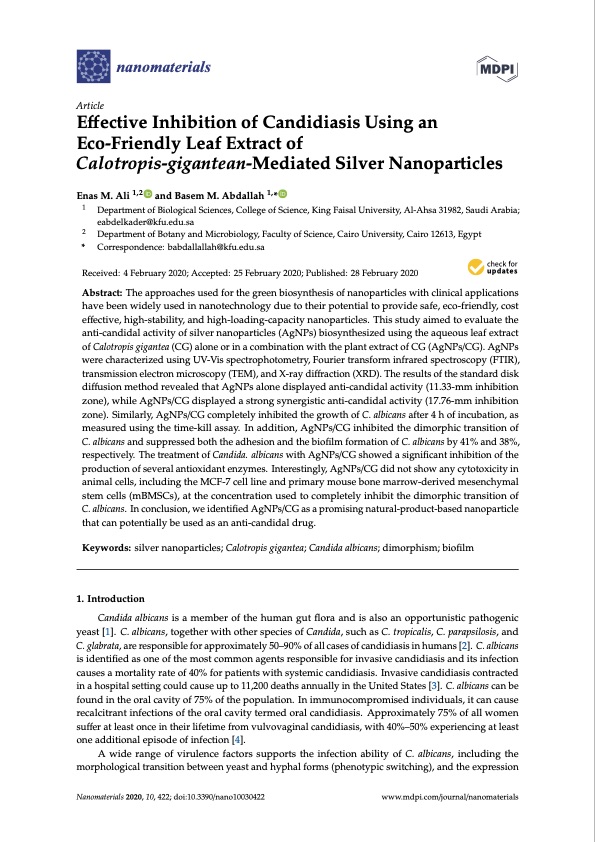
PDF Publication Title:
Text from PDF Page: 001
nanomaterials Article Effective Inhibition of Candidiasis Using an Eco-Friendly Leaf Extract of Calotropis-gigantean-Mediated Silver Nanoparticles Enas M. Ali 1,2 and Basem M. Abdallah 1,* 1 Department of Biological Sciences, College of Science, King Faisal University, Al-Ahsa 31982, Saudi Arabia; eabdelkader@kfu.edu.sa Department of Botany and Microbiology, Faculty of Science, Cairo University, Cairo 12613, Egypt 2 * Correspondence: babdallallah@kfu.edu.sa Received: 4 February 2020; Accepted: 25 February 2020; Published: 28 February 2020 Abstract: The approaches used for the green biosynthesis of nanoparticles with clinical applications have been widely used in nanotechnology due to their potential to provide safe, eco-friendly, cost effective, high-stability, and high-loading-capacity nanoparticles. This study aimed to evaluate the anti-candidal activity of silver nanoparticles (AgNPs) biosynthesized using the aqueous leaf extract of Calotropis gigantea (CG) alone or in a combination with the plant extract of CG (AgNPs/CG). AgNPs were characterized using UV-Vis spectrophotometry, Fourier transform infrared spectroscopy (FTIR), transmission electron microscopy (TEM), and X-ray diffraction (XRD). The results of the standard disk diffusion method revealed that AgNPs alone displayed anti-candidal activity (11.33-mm inhibition zone), while AgNPs/CG displayed a strong synergistic anti-candidal activity (17.76-mm inhibition zone). Similarly, AgNPs/CG completely inhibited the growth of C. albicans after 4 h of incubation, as measured using the time-kill assay. In addition, AgNPs/CG inhibited the dimorphic transition of C. albicans and suppressed both the adhesion and the biofilm formation of C. albicans by 41% and 38%, respectively. The treatment of Candida. albicans with AgNPs/CG showed a significant inhibition of the production of several antioxidant enzymes. Interestingly, AgNPs/CG did not show any cytotoxicity in animal cells, including the MCF-7 cell line and primary mouse bone marrow-derived mesenchymal stem cells (mBMSCs), at the concentration used to completely inhibit the dimorphic transition of C. albicans. In conclusion, we identified AgNPs/CG as a promising natural-product-based nanoparticle that can potentially be used as an anti-candidal drug. Keywords: silver nanoparticles; Calotropis gigantea; Candida albicans; dimorphism; biofilm 1. Introduction Candida albicans is a member of the human gut flora and is also an opportunistic pathogenic yeast [1]. C. albicans, together with other species of Candida, such as C. tropicalis, C. parapsilosis, and C. glabrata, are responsible for approximately 50–90% of all cases of candidiasis in humans [2]. C. albicans is identified as one of the most common agents responsible for invasive candidiasis and its infection causes a mortality rate of 40% for patients with systemic candidiasis. Invasive candidiasis contracted in a hospital setting could cause up to 11,200 deaths annually in the United States [3]. C. albicans can be found in the oral cavity of 75% of the population. In immunocompromised individuals, it can cause recalcitrant infections of the oral cavity termed oral candidiasis. Approximately 75% of all women suffer at least once in their lifetime from vulvovaginal candidiasis, with 40%–50% experiencing at least one additional episode of infection [4]. A wide range of virulence factors supports the infection ability of C. albicans, including the morphological transition between yeast and hyphal forms (phenotypic switching), and the expression Nanomaterials 2020, 10, 422; doi:10.3390/nano10030422 www.mdpi.com/journal/nanomaterialsPDF Image | Inhibition of Candidiasis Calotropis Silver Nanoparticles

PDF Search Title:
Inhibition of Candidiasis Calotropis Silver NanoparticlesOriginal File Name Searched:
nanomaterials-10-00422-v3.pdfDIY PDF Search: Google It | Yahoo | Bing
Turbine and System Plans CAD CAM: Special for this month, any plans are $10,000 for complete Cad/Cam blueprints. License is for one build. Try before you buy a production license. More Info
Waste Heat Power Technology: Organic Rankine Cycle uses waste heat to make electricity, shaft horsepower and cooling. More Info
All Turbine and System Products: Infinity Turbine ORD systems, turbine generator sets, build plans and more to use your waste heat from 30C to 100C. More Info
CO2 Phase Change Demonstrator: CO2 goes supercritical at 30 C. This is a experimental platform which you can use to demonstrate phase change with low heat. Includes integration area for small CO2 turbine, static generator, and more. This can also be used for a GTL Gas to Liquids experimental platform. More Info
Introducing the Infinity Turbine Products Infinity Turbine develops and builds systems for making power from waste heat. It also is working on innovative strategies for storing, making, and deploying energy. More Info
Need Strategy? Use our Consulting and analyst services Infinity Turbine LLC is pleased to announce its consulting and analyst services. We have worked in the renewable energy industry as a researcher, developing sales and markets, along with may inventions and innovations. More Info
Made in USA with Global Energy Millennial Web Engine These pages were made with the Global Energy Web PDF Engine using Filemaker (Claris) software.
Infinity Turbine Developing Spinning Disc Reactor SDR or Spinning Disc Reactors reduce processing time for liquid production of Silver Nanoparticles.
| CONTACT TEL: 608-238-6001 Email: greg@infinityturbine.com | RSS | AMP |